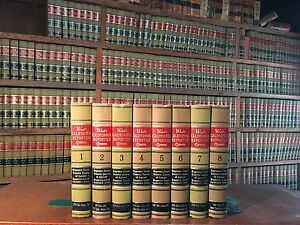
The Legislative Bill Room, California State Capitol. (Photo: ca.gov)
Additional Bill Drafting Guidelines
The bill drafter should know these rules as courts will look at statutes with these rules in mind
By Chris Micheli, October 14, 2020 6:33 am
The following are some additional guidelines for successfully drafting legislation in California:
Rules of Punctuation
Punctuation is an important part of drafting legislation and the punctuation rules should be used consistently and properly. The bill drafter should know these rules as courts will look at statutes with these rules in mind. As such, the drafter needs to follow these standard rules of punctuation and even conform existing statutes if necessary.
Internal References
When a bill drafter is amending or repealing code sections, he or she needs to ensure that the proposed changes are consistent with existing code sections. If the proposed changes would create a conflict with an existing code section, then the drafter must amend or repeal the existing code section to making reference to and conforming the existing code sections to changes that are being made in other amended or repealed sections of the same bill.
In referring to other parts of a bill, the drafter should refer to specific code sections. Avoid references such as “herein,” “hereinbefore,” “hereinafter,” “preceding,” “above,” and “following,” since these references can create ambiguity.
Definitions
As a general rule, a bill drafter should place a definitions section that applies to an entire title, chapter or article in a separate code section at the beginning of that title, chapter or article. Place the definitions in alphabetical order. A clearly written draft needs very few definitions. Words used in their ordinary senses do not need definitions.
In addition, a definition that is restrictive is usually followed by the word “means.” On the other hand, a definition that is extensive is usually followed by the word “includes.”
Appropriations Measures
In general, an appropriation of public monies should contain the following main provisions:
• An amount of monies. (e.g., “The sum of $___”)
• A source of the monies. (e.g., “is appropriated from ___”)
• A fiscal year. (e.g., “in fiscal year ____”)
• A recipient of the monies (either a fund or a state agency). (e.g., “to ___”)
• A purpose of the monies. (e.g., “for the purpose of ___.”)
Synonyms
As a general rule, a bill drafter should avoid the use of synonyms. A change in wording may be construed to convey a change in meaning, which is likely to cause confusion for an executive agency or a court when interpreting the language.
Acronyms
As a general rule, a bill drafter should avoid the use of acronyms. An acronym may be used as an abbreviation of a scientific, medical, or technical term if the acronym is defined and is otherwise commonly known (e.g., “AIDS”).
Quotation Marks
As a general rule, periods and commas do not appear inside quotation marks unless the punctuation is part of the quoted material. Do use quotation marks when defining a term.
Parentheses
As a general rule, do not use parentheses to mark off explanatory or qualifying remarks; instead, use commas instead of parentheses or put them in a separate sentence. However, the bill drafter should use parentheses to set off the identifying numbers or letters of subsections and subdivisions.
Numbers
As a general rule, the bill drafter should write numbers as both words and numerals. Enclose the numerals with parentheses.
Commas
As a general rule, in a series separated by commas, always use a comma before the conjunction. Also, a subordinate clause at the beginning of a sentence is followed by a comma, and a subordinate clause in the middle of a sentence is enclosed with commas.
Possessives
In order to form the possessive of a common singular word ending in “s”, add an apostrophe and “s” unless the next word begins with an “s”, in which case add just the apostrophe.
Creating New State Entities
When the Legislature decides to establish a new agency, board, or commission, there are quite a few issues that will need to be addressed for the bill drafter. Just a few of the key points that need to be considered in drafting a bill to create a new state entity include:
- Name of the entity
- Its general purpose
- Whether it is independent or a line entity
- Board members (including number, term of office, etc.)
- Appointment and removal of board members
- Whether they are paid or unpaid positions
- Staff for the entity
- Promulgation of regulations
- Duties of entity
- Hearings
- Licenses, permits
- Testing of licensees
- Regulation of licensees
- Auditing and accounting
- Appeals from agency decision
- Funding the agency
- Fees
Avoiding Ambiguity
Often ambiguity is the result of unclear sentence structure or poor placement of words or phrases. In addition, the combinations of nouns and their modifiers are often a cause of trouble.
Length of Sentences
Sentences in the law are often long and they seem to grow longer. Sometimes the longer the sentence, the more likely it is that the statute’s reader will have to ask questions about which words modify other words or which parts of the sentence go together? To avoid confusion for readers of statute, then bill drafters should write short sentences when possible and, if long sentences must be used, then make the structure clear.
Establishing a Condition
Often a statute sets forth a simple, general proposition that is subject to certain conditions and exceptions. Conditions and exceptions are often added by amendment and, the more conditions and exceptions that apply, then generally the longer and more complex the statute becomes. As a result, the bill drafter needs to organize the statute so that the general proposition remains clear while the conditions and exceptions are provided later.
In General
Use short, familiar words and phrases that best express the intended meaning and avoid long words, especially when a short word will convey the same message. In addition, if it is possible to omit a word and still maintain the meaning of the sentence, then the bill drafter should omit the word. Be consistent in your word usage and structure of the statute. And, if possible, state a requirement directly rather than by use of exceptions.
Preliminary Drafting Steps
The bill drafter should first ascertain the goal of the bill to be drafted and how the legislator wants it prepared. Second, review the applicable statute(s), as well as other statutes on the topic to determine whether a similar or related statute is in effect. Third, review any recent amendments to the statute(s) as well as annotations, such as court decisions. Fourth, check whether there were similar bills proposed in prior years. Fifth, check the federal and state constitutions. Sixth, if proposed legislation indicates the need for a new section, article or chapter, the bill drafter needs to determine the appropriate place in the code for it.
Organization of the Bill
The bill drafter should begin with an outline of the proposed legislation. Some of the major provisions to consider include: the core purpose of the bill; its general application, including the scope and nature of the measure; any special rules; and, possible remedies.
The National Conference of Commissioners on Uniform State laws provides the following suggested order of arrangement:
- Short title
- Definitions
- Scope, applicability, exceptions, exclusions, if any
- Administrative and procedural provisions
- Substance – positive requirements in order of time, importance, or other logical sequence
- Prohibitions and penalties
- Uniformity of application and construction clause
- Relation to other laws
- Savings and transitional provisions, if any
- Severability, if needed
- Repeals, if needed
- Effective date, if needed.
The information provided above are just some of the many considerations that need to be considered by the bill drafter.
- General Provisions Related to Family Law Support - December 13, 2025
- Petitions for Forming Harbor Districts in California - December 12, 2025
- Child Support Obligations - December 12, 2025




